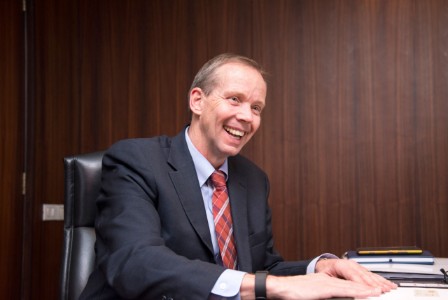What I find interesting about the CFO job is that you can make of it what you want.
People power
In total, Sweet has spent more than two decades with Dell Inc. and Dell Technologies, a period that he describes as an “extraordinary learning experience.” He joined the company as Finance Director for its education sales segment in 1997 and has held a number of finance positions over the years, including that of Chief Accounting Officer. Since 2014 he has been CFO, a role he thinks of “as all-round enabling the vision for the company.”
He explains: “That enablement includes ensuring that we’re executing the business model, and that we are driving the appropriate financial reporting and tax compliance. So it’s not just about me adding up the numbers at the end of the quarter. It’s about being at the forefront of aiding Michael as he drives the company forward.”
Sweet is focused on enabling the teams who work for him. In fact, he’s very clear that the merger with EMC would not even have been possible had he not had “great people” in his teams who were able to free him up to focus on helping to close the transaction. So his advice for other CFOs about to take on a mega-merger is to find talented people and empower them, while establishing monitoring capabilities to ensure everyone stays aligned.
Related article
Two become one
As CFO, Sweet played a key role in the integration team that brought Dell and EMC together. Naturally, he concentrated largely on the financial structuring of the transaction, which took more than a year to arrange and involved bank loans, as well as the issuance of bonds and equities. Additionally, he was involved in setting the future strategic direction for the enlarged business.
The premise for the merger was that it would combine Dell’s expertise in enterprise servers, personal computers and mobile devices with EMC’s storage capabilities.
“The vision was there,” says Sweet, “so then the question was, how do we build out that premise in more depth? What are the strengths and weaknesses of the respective companies? What’s the competitive reaction? What’s the customer receptivity? Lots of work was done around those aspects of putting the two companies together to ensure we had the merger positioned properly, or at least understood where friction points might arise.”
Cost synergies
Sweet went into the merger believing that it could also drive cost synergies through the rationalization of core capabilities, support functions and supply chains. “What we found when we got into it was that we mostly got the cost synergies we were expecting, with the exception of one area: sales,” he says. “But we also realized that much more reinvestment in the business needed to happen.”
As a result, much of the money saved went back into the business to build additional capability. And sales, an area where Sweet had expected to find redundant capacity, actually secured additional investment because the sales teams needed extra resources. “It was the right investment to make,” Sweet explains. “I remember sitting down with Michael and the sales leadership team and saying, ‘Look, I’m not a fan of spending money per se, but in this case it’s the right thing to do.’”
While the cost synergies didn’t turn out as anticipated, compensation came in the form of better-than-expected revenue synergies. Only about 20% of the combined customer base of the enlarged company already used both Dell and EMC. As a result, the sales teams had a strong opportunity to sell into the other 80% – an opportunity they seized.
It’s not just about me adding up the numbers at the end of the quarter. It’s about being at the forefront of aiding Michael as he drives the company forward.
Today, Dell Technologies’ strategic priority is to be an infrastructure company that will help customers to realize their digital future.
“If you think about technology trends, and the transformation that’s happening in the business environment, it’s no longer about customers buying IT infrastructure because otherwise their back office won’t work effectively,” says Sweet. “Today, technology is an enabler. It’s about the differentiation that technology provides to help businesses become successful.”
It is clear that Dell Technologies is not a company that likes to stand still. In fact, it was only a couple of years before the EMC merger was announced that Dell Inc. was taken private in a US$24.4b deal. So what will happen next?
“There will be another act,” Sweet predicts confidently. And that next act is bound to present him with more exciting opportunities to help shape the future of the business. As he says of his role: “What I find interesting about the CFO job is that you can make of it whatever you want.”
The views of third parties set out in this article are not necessarily the views of the global EY organization or its member firms. Moreover, they should be seen in the context of the time they were made.
Summary
In 2016, Dell Inc. merged with EMC. As CFO of Dell, Tom Sweet was responsible for the financial structuring of the deal. In this article, Tom explains how it worked and what he learned from the process.


